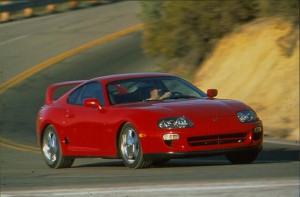Toyota’s long-lamented sports car, the Supra, could be headed for a revival, at least if the maker’s new chairman gets his way.
Produced from 1978 to 2002, the Toyota Supra once represented the pinnacle of the maker’s design and engineering capabilities, but it was pulled from production due to a variety of factors – leaving long-time fans calling for its return ever since.
The loss of the Supra was, to critics, one more step backward for Toyota as it morphed into a plain vanilla brand best known for quality, reliability and boring green machines like the Prius. As the recent unveiling of a more stylish Corolla, as well as the introduction of the Scion FR-S sports car, demonstrate, Toyota is finally recognizing the need to put more passion into its products.
That could be underscored next autumn when Toyota and BMW pull the covers off the new sports car they are jointly developing during a preview at the 2013 Tokyo Motor Show. It’s expected to be larger and deliver better performance than the FR-S, which Toyota also sells in many markets as the GT-86.
“It’s futile if we make something similar to the 86,” incoming chairman Takeshi Uchiyamada told the Bloomberg news service during an interview in Osaka. Known as the “father of the Prius,” Uchiyamada said he’d like something much more comparable in power, performance and positioning to the old Supra – though he also cautioned the final specs are not his to call.
“That’s what I want, but it’s not me who makes the decision,” said Uchiyamada.
The FR-S/GT-86 was itself the result of a joint venture between Toyota and Subaru, the smaller maker marketing its version under the BRZ nameplate.
Long reluctant to partner with erstwhile competitors, Toyota has recently reversed course. It has, for example, teamed up with Ford on several projects that include the development of hybrid technology that can be used on large trucks – perhaps future versions of the Ford F-150 and Toyota Tundra.
Meanwhile, the Japanese giant has several programs going with BMW, including sourcing German diesel engines for use in Toyota products sold in Europe.
Then there’s the new sports car program, which is set to be unveiled in Tokyo late this year. How much it might resemble a modern-day take on the last Toyota Supra remains to be seen – as does any decision about reviving the Supra nameplate, though the 66-year-old Uchiyamada certainly could have a strong say when he steps into his new role, the second-highest position next to President Akio Toyoda.
The Supra was launched in Japan in 1978 and was a popular mainstay in the American market until 1998. It continued in production for Japanese buyers for another four years. Part of the problem was that the sports car couldn’t comply with tightening emissions standards. The more powerful – but dirtier turbo version was yanked from the American market in 1996.
But the last Toyota Supra had also grown too expensive – at least for the time. That also drove several other Japanese sports car out of the market, including the last-generation Mazda RX-7 and the Nissan Z-Car which has since been revived.


Niche marketing is usually good for the brand if they deliver a quality product.
The Supra, 300ZX and RX-7 of the late 80s and early 90s were great cars. The Mitsubishi 3000GT / Dodge Stealth was probably not in the same league, but close. Powerful, modern engines, independent suspensions, Japanese reliability, decent styling, and affordable prices.
Problem was that their makers (Toyota, Nissan, Mazda and Mitsubishi) kept loading them up with luxo-type options and raising their prices until they became bloated and over-priced, kind of like the BMW M3 these days.
It’d be great if Toyota would come up with a nimble, lean and mean sports car worthy of that name. And if Honda would come up with a replacement for its S2000. True sports cars which bring a huge grin to your face every time you slip behind their steering wheel.